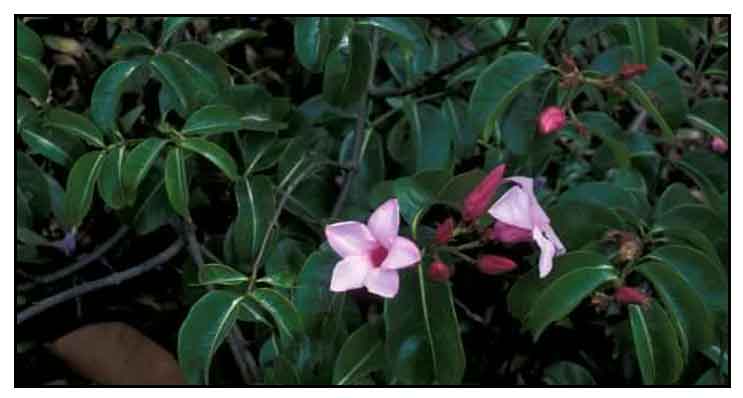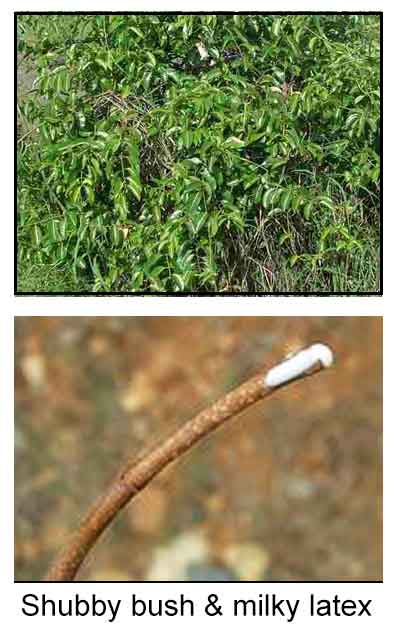 Botany Botany
Cryptostegia grandiflora is a stout, woody vine. Leaves are oblong-ovate to elliptic-ovate, 6 to 10 centimeters long, pointed at the tip, rounded at the base. Cymes are short. Sepals are green, about 8 millimeters long. Corolla is pale purple, about 4 centimeters long, and often wider than it is long. Woody follicles are 10 to 12 centimeters long.
 Distribution Distribution
- Recent introduction to the Philippines.
-
Planted for ornamental purposes.
- Now, pantropic.
- Native of India.
- In some countries, it has escaped cultivation and has become invasive, capable of smothering trees and reducing biodiversity and degrading habitat. It can form dense, impenetrable thickets that can impede stock movements and access to water. (23)
Constituents
- Phytochemical studies of flowers yielded two cardenolides, oleandrigenin and gitoxigenin, as well as, two flavonoid glycosides, hyperoside and astragalin, and their aglycones, quercetin and kaempferol. (6)
- Latex of fresh unripe fruits yielded
b-amyrin, lupeol, a-amyrin, b-sitosterol and b-sitosterol–3-O-b-D-glucoside, in addition to a phenolic glucoside 2,4,6-trihydroxy benzophenone-2-O-b-D-glucopyranoside. (6)
- Hexane and ethyl acetate extracts yielded a mixture of phytosterols and triterpenoids, lanosterol, B-sitosterol, stigmasterol, campesterol, friedelin, lupeol, ursolic acid, and B-amyrin.
- Oil fraction yields both saturated and unsaturated fatty acids, including palmitic acid (25.90%), linoleic acid (24.76%), arachidic acid (22.28%), myristic acid (15.24%), oleic acid (8.0%), stearic acid (3.8%), and traces of lauric acid. (see study below) (15)
-
Preliminary phytochemical screening of various extracts yielded glycosides, flavonoids, fixed oils and fats, phenolic compounds, protein and amino acids, tannins, gum and mucilage and carbohydrates. Methanol extract of leaves yielded cardiac and saponin glycosides, tannins, flavonoids, proteins. (26)
Properties
- Plant considered an irritant and poisonous.
- Leaves have reported toxicity. (see study below) (12)
- In some countries, the plant has escaped cultivation and has become invasive, threatening biodiversity in some places. It is poisonous to stock, 10 gms of leaves can reportedly kill a 400 kg horse in six days. While unpalatable, animals eat it under drought conditions. (18)
- The vine exudes a milky latex which can be made into natural rubber. However, it is difficult to tap for commercial purposes. (18)
- Studies have suggested antimicrobial, antiviral, analgesic, molluscicidal, anti-inflammatory, antioxidative, proteolytic properties.
Parts used
Leaves, roots.
Uses
Folkloric
- No reported folkloric medicinal use in the Philippines.
- In Madagascar, reportedly used for criminal purposes and against vermin.
- Powdered leaves, mixed with water, when swallowed can cause persistent vomiting after half an hour; death in 15 hours.
- In Madhya Pradesh, India, root paste is applied externally on chest to cure asthma. (10) In Andhra Pradesh, whole plant applied to wounds. (25)
- In Nigeria, leaves and latex used for fungal and heart problems. (21)
Studies
• Antiviral / HSV1: Study screened 18 plants with ethnomedical background from different families for antiviral activity against Herpes simplex virus-1 (HSC-1). The extract of Cryptostegia grandiflora showed partial activity at higher concentrations, with CPE (cytopathic effect) ++ at 2 and 10 TCID50, + at 100 TCID50. (1)
• Cardiac glycosides: Study of the leaves of C. grandiflora yielded four news cardiac glycosides: crptostigmin I to IV together with two known cardenolides. (2)
• Antibacterial: Study of the different extracts of Cryptostegia grandiflora was done for antibacterial potential against Pseudomonas cepacia, B megatorium, S aureus, E coli B subtilis. Almost all extracts produced significant antibacterial activity against all the microorganisms, comparable to standard antibiotic tetracycline hydrochloride. The petroleum ether extract showed maximum efficacy. (3)
• Latex Pro-Inflammatory Activity: Study investigating the pro-inflammatory activity of the latex of C grandifolia was investigated. Results showed the soluble proteins of the latex induced strong inflammatory activity, enlarged vascular permeability and increased myeloperoxidase activity locally in rats. It concludes that the latex of CG is a potent inflammatory fluid and implicates lactifer proteins in that activity. (4)
• Antimicrobial: Study isolated compounds from hexane and ethyl acetate extracts isolated a mixtures of phytosterols and triterpenoids. Lanosterol, a triterpenoid, was most active against E. coli and campesterol had greater activity against Candida albicans. (7)
• Analgesic / Acute Toxicity Study / Leaves: Study in mice evaluated the analgesic property of a methanol leaf extract of Cryptostegia grandiflora. The extract did not show any toxicity up to 5000 mg/kbw. All three test doses showed significant analgesic activity, although less than standard acetylsalicylic acid in the writhing test. (8)
• Molluscicidal / Latex: Study of latex aqueous solution of C. grandiflora showed a significant increase of snail amoebocytes, a component of the internal defense system, decreasing its compatibility to Schistosoma mansoni. Results suggest Cg may be useful for snail control. (9)
• Toxicity Manifesting as Hyerpkalemia, Heart Block and Thrombocytopenia: Study reports a case of toxicity associated with consumption of extract of leaves of C. grandiflora which led to gastrointestinal, cardiac, electrolyte, and hematological disturbances. Serum potassium level was 9 mmol/L. Indian rubber vine contains cardiac glycosides responsible for the digitalis-like toxicity on consumption of leaves. (12)
• Electrocardigraphic Toxicity: Cryptostegia grandiflora poisoning results in bradycardia. Cardiac glycosides inhibit cellular Na+/K+-ATPase which enhances cardiac inotropy (contractility) and slows down the heart rate. (24)
• Anti-Inflammatory / Leaves: Study evaluated the effect of total extract and primary fractions of CG leaves using in vivo and in vitro models of inflammation. Results showed anti-inflammatory activity contributed to by its antioxidant activity and inhibition of MPO (myeloperoxidase) activity, and PGE2 and NO production. (13)
• Anti-Oxidative and Proteolytic Activities: Study evaluated the proteolytic, chitinolytic and anti-oxidative activities of proteins extracted from three plants. C. grandiflora latices showed strong anti-oxidative activity of superoxide dismutase and strong proteolytic activity. (14)
• Potential Multi-Use Crop: Study evaluated C. grandiflora for its potential as a multi-use crop. The plant yielded 14.0% protein, 6.5% oil, 6.9 polyphenol, and 2.13% hydrocarbon. Gross heat value was 3878.0 cal/g, while the oil fraction was 7350.1 cal/g and the hydrocarbon fraction 9300 cal/g. Oil fraction yields both saturated and unsaturated fatty acids, including palmitic acid (25.90%), linoleic acid (24.76%), arachidic acid (22.28%), myristic acid (15.24%), oleic acid (8.0%), stearic acid (3.8%), and traces of lauric acid. The high proportion of saturated FA and high oil content (<5.0%) suggest a potential source for industrial raw material and alternative for conventional oil. (15)
• Anti-Proliferative / Antioxidant / Leaves: Study evaluated the antiproliferative and antioxidant activity of C. grandiflora leaves. Results showed antioxidant activity which may be attributed to the significant amount of catecholamine like phenol molecules in the leaves extract. The extract also showed anti-proliferative activity against colorectal adenocarcinoma (Caco-2) cell line at a concentration of CTC50 750 µg/mL (75.7%). (17)
• Schistosomicidal Activity: A study evaluated 346 methanol extracts from 281 Egyptian plant species for in vitro schistosomicidal activity. Forty-two were confirmed to have in vitro antischistosomal activity, and of these 14 plant species, including Cryptostegia grandiflora, showed high antischistosomal activity with LC50 ≤ 15 µg/ml. (20)
• Antitumor / Cytotoxic Cardenolides: Study of an alcoholic extract of above ground parts of C. grandiflora and fractionation yielded five cardenolides: oleandrigenin (1), 16-propionylgitoxigenin, a new natural product (2), 16-anhy drogitoxigenin (3), gitoxigenin (4), and rhodexin B (5). Results showed inhibitory activity against KB cell culture. Although all five cardenolides showed cytotoxic properties, only 1, 4, and 5, possibly 2, showed significant activity by CCNSC protocol. (22)
Availability
Wild-crafted.
|

![]()





